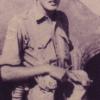‘TUNISIA 1942 – 1943’.
By Neville Robinson. Intelligence Section 2nd Para Bn
We were lightly armed and equipped during the campaign, and had to rely on other Units for Anti-Tank defence. At the beginning our only anti-tank weapon was the Boyes Anti-Tank Rifle a cumbersome 0.45inch calibre long Rifle with a huge recoil that would put your shoulder out of
joint. It was useless against the Panzer Mk4 & 5’s but one of the CSM’s (a big chap) kept one as his personal weapon and did some sniping with it during the attack by the Austrian Alpenjager Battalion at Happy Valley (with success).
Towards the end of the campaign a number of us were sent back to a demonstration by the 78th Infantry Division of the new ‘Wonder Weapon’ which would replace the ‘Boyes’. It was called the Projector Infantry Anti-Tank or ‘P.I.A.T.’ this was a long semi-tube with a spring inside that launched a bomb with the ability to burn a small hole in a tank and enough force to dislodge the armour plate and spread it around the inside of the tank.
The P.I.A.T. was meant to re-cock itself by the cartridge at the back of the bomb, but it seldom did and had to be re-cocked by putting both feet on the butt and pulling the whole tube against the spring until it locked. If you got a chance to do it standing up it wasn’t too bad, but lying down and keeping under cover was a whole different ‘Tug of War’!
We were often supported by the 25 -pounders of the Newfoundland Regiment of Artillery, they were not part of the Brigade then but part of the R.A. In 1916 they had been massacred at Beaumont Hamel on the first day of the battle of the Somme, and had lost a generation of young men, so were converted from Infantry to Artillery. Today there are 2 Battalions of the Royal Newfoundland Regiment a Militia Infantry Unit.
A problem in the Atlas mountains was hitting the German positions on the reverse slopes (crest clearance) as the 25 pounders did not fire in the upper register. So Indian gunners appeared with the old 18 pounder mountain guns which broke down into Mule loads and they fired high angle and beefed up our 3inch Mortars. In some positions we had US Army 37mm Anti-Tank guns and then the British 6 pounders with the RA Gunners. The first Tank to be stopped by the 6 pounder were the big new Tiger as there had been nothing much to stop them before. The 2 pounders on the Churchill Tanks and in the RA Anti-Tank Batteries bounced off like peas.
If you get the impression that 1st Army was a bit of a rag tag mixture of Units - well it was. It grew steadily though, and for the last attack at Tamera we had the most support yet including 18 pounders, 25 pounders, 5.5 inch mediums and 7.2 inch heavies with Bofors 40mm firing down the flank of the night attack to keep us heading for the right objective, the 7.2’s sounded like trains going over. After Tamera we moved to positions just in front of ‘GREEN HILL’ and ‘BALDIE’ two large Djebel’s astride the road to Bizerte held by the Germans. Earlier in the war the 16th Battalion, The Durham Light Infantry had moved by night to a position right below these two Djebel’s which was all bare rock with no way to dig in. As the dawn broke the Germans caught them in the open and they had suffered badly, the area was full of debris and it was not unusual to see Bren Guns and Rifles cut in half by shrapnel and rock slices.
We patrolled by night and kept behind cover all day. After a couple of weeks the US 9th Infantry Division relieved us, they were meant to do a night relief but were delayed and we looked back to that entrance to the valley in the morning to see a green tide of vehicles swarming into the valley.
The Luftwaffe had been very regular over the valley, and every morning two M.E 109’s used to come over low looking for targets to strafe before the RAF Spitfire’s could nail them.
Every vehicle in the US Division had either a .30 or a .50 calibre Machine Gun on it, and their drill was to point everything skyward and hold the trigger down. We had called the two ME 109’s ‘Mutt’ & ‘Jeff’ and as they swept in from the East their eyes must have bulged at the valley full of vehicles, but suddenly the valley was full of vertical lines of tracer bullets, and ‘Mutt’ & ‘Jeff’ climbed straight up into the blue and high tailed it for home. Then we climbed into the old Bedford 3 Ton Trucks and went into 5 Corps reserve until we got into the ‘Hommes 40, Chevaux 8’ rail cars and rattled our way to Mascara where the rest of 1st Airborne Division (which we had never heard of) was waiting for us.
End.
Source:
Researched by R Hilton
Read More




Latest Comments
There are currently no comments for this content.
Add Comment
In order to add comments you must be registered with ParaData.
If you are currently a ParaData member please login.
If you are not currently a ParaData member but wish to get involved please register.